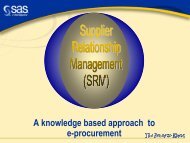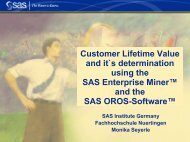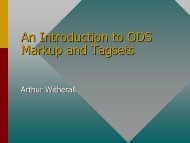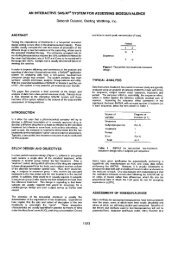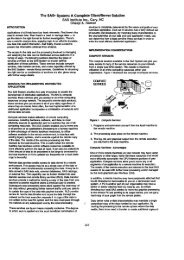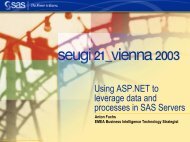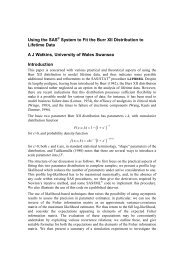Oda Bellingrath, dibera Building a data warehouse often does not ...
Oda Bellingrath, dibera Building a data warehouse often does not ...
Oda Bellingrath, dibera Building a data warehouse often does not ...
Create successful ePaper yourself
Turn your PDF publications into a flip-book with our unique Google optimized e-Paper software.
<strong>Oda</strong> <strong>Bellingrath</strong>, <strong>dibera</strong><br />
<strong>Building</strong> a <strong>data</strong> <strong>warehouse</strong> <strong>often</strong> <strong>does</strong> <strong>not</strong> solve the following problems:<br />
There are still programming skills needed to analyze, select , sort and summarize the<br />
requested <strong>data</strong>, to produce reports, to define and view drill-down levels, ...<br />
As a controller or an executive you just do <strong>not</strong> want to deal with this. You are familiar<br />
with the look-and-feel of your spreadsheet application and that is exactly what you<br />
want for retrieving the information you need.<br />
Often your field organisation or branch office can <strong>not</strong> get access to the information<br />
they have to work with. Or your field staff has to deal with complicated update<br />
mechanisms to keep their reports up to date, instead of having direct access to the<br />
enterprise-wide <strong>data</strong> <strong>warehouse</strong> by using a laptop, a modem and just a browser<br />
software.<br />
The tool dib-eisa is the solution for the above mentioned problems. It uses the power<br />
of SAS TM to provide enterprise-wide informations for any hardware-platform, network<br />
system and all kinds of <strong>data</strong>bases. The training period to get familiar with dib-eisa<br />
applications is short. Basic PC knowledge is required.<br />
Initially dib-eisa was developed for a controlling division of a large German insurance<br />
company to cover all important issues concerning information retrievement of an<br />
existing <strong>data</strong> <strong>warehouse</strong>. In the past three years different kind of easy-to-use<br />
applications have been developed with the dib-eisa tool, e.g.<br />
ä production planning<br />
ä forecasting procedures<br />
ä cost-management<br />
ä contribution costing<br />
ä customer analyses<br />
ä marketing <strong>data</strong>base<br />
ä portfolio-analyses.
Nowadays it is used by many companies in the insurance and banking industry as<br />
well as other business branches in Germany, Austria and Switzerland.<br />
This paper describes the functionality of dib-eisa, the technical background and the<br />
dib-eisa components and how they work together.<br />
The functionality of dib-eisa is a combination of a spreadsheet and <strong>data</strong> <strong>warehouse</strong><br />
needs.<br />
dib-eisa is attached on top of the existing <strong>data</strong> <strong>warehouse</strong>. Data can be stored in any<br />
format or combination of different formats. The entire power and flexibility of SAS TM<br />
can be used to access <strong>data</strong>. You can even use statitical methods to enhance your<br />
existing <strong>data</strong> with forcasting time tables.
An administrator determines description tables to define user views. These definitions<br />
include<br />
ä the applications the user is allowed to run,<br />
ä predefined views,<br />
ä display list and graphic output,<br />
ä the <strong>data</strong> selections and filtering(e.g. which<br />
variables are shown),<br />
ä the drill down levels (e.g. distribution levels or<br />
sales sectors),<br />
ä traffic lighting and<br />
ä many more selections, depending on the<br />
application.<br />
Additionaly the user can easiliy adapt these tables to create and save new individual<br />
views. The user can<br />
ä define drill-down levels,<br />
ä drill even in graphhical output,<br />
ä sort <strong>data</strong>,<br />
ä define and compute analyses variables,<br />
ä export <strong>data</strong> to Excel or other spreadsheets or formats,<br />
ä print,<br />
ä ...<br />
There are simply no restrictions concerning the ways of analyzing your <strong>data</strong><br />
<strong>warehouse</strong>.
At first dib-eisa was designed as a tool on classical client-server bases. This May we<br />
have implemented the first prototype of dib-eisa/WWW on SAS/IntrNet TM bases.<br />
Both tools have the same look-and-feel and offer nearly the same functionality. Even<br />
the techniques to access and select <strong>data</strong> are similar. Once you have implemented<br />
an application with the tool dib-eisa, the programming effort to write a dib-eisa/WWW<br />
application on SAS/IntrNet TM bases is relatively low.<br />
But the technical background, the requirements for client and server are different.<br />
Also the clients, using the tool, can (but <strong>not</strong> have to) be distinguished.<br />
The user selects a dib-eisa application and defines <strong>data</strong> selections, drill-down levels<br />
and cross tables. These informations are submitted remote to the server. A SAS TM<br />
Macro on the server selects, processes and summarizes the <strong>data</strong> and computes drilldown<br />
levels. The entire functionality of SAS TM can be integrated in this macro. The<br />
macro processing results in a work-file that is downloaded to the client. User actions<br />
are analyzed by the application, resulting in different views of the work-file.
MS Windows 3.11 / Windows 95/ Windows NT/ OS2/ UNIX or combinations of<br />
operational systems in a client server environment that is capable to run SAS TM .<br />
The client should be a Pentium PC, 60 MHz or higher, 18 MB minimum of hard disk<br />
space and 16 MB RAM (32 MB or higher recommended).<br />
TM<br />
Administrators of dib-eisa applications are pleased with the fact that dib-eisa/WWW is<br />
based on the same <strong>data</strong> retrieval concept while users appreciate the same look-andfeel.<br />
Though the technical background is basically different:<br />
Starting a Web browser the user is selecting a dib-eisa/WWW application and<br />
requests the (HTML formattted) dib-eisa document from the Web server. The server<br />
responds by sending the document to the browser. The browser detects the included<br />
Java applet tag in the document and sends additional requests to the Web server.<br />
<br />
Java classes used by the applet are downloaded to the client machine. The applet<br />
begins to run.<br />
The applet starts a SAS/Connect TM session on the server machine and connects to<br />
that remote SAS TM session. The session is destroyed when the applet has finished<br />
execution.
Interactively the user can select views, sort <strong>data</strong>, drill down through distribution or<br />
other levels and display list and graphic output. The Java applet takes control of the<br />
user actions. Users are having interactive access to SAS <strong>data</strong> without having<br />
SAS TM software installed on the client pc.<br />
The client can be a so-called thin client (e.g. a Net Computer), but must have<br />
network access to the Web server . A Java enabled Web browser (e.g. Netscape<br />
Navigator 3.0 or higher or MS Internet Explorer 3.02 or higher) must be installed. No<br />
hard disk space is required but a minimum of 32 MB RAM.<br />
On the Web server the Java tools must be installed. Using JTunnel a directory for<br />
CGI-programs (e.g. \cgi-bin\) must have been setup.<br />
The SAS TM release 6.12 or higher must be installed on the SAS TM server, including<br />
SAS/ IntrNet TM software, SAS/Share TM and SAS/Connect TM software.<br />
TM<br />
dib-eisa/WWW is using Java tools being components of SAS/IntrNet TM Software:<br />
Two drivers (set of Java class libraries that communicate with a SAS TM server) are<br />
used to write Java programs:<br />
ä JDBC (a „reduced“ ODBC-driver) is written in Java and gives users interactive<br />
access to view and update <strong>data</strong> without having SAS TM software installed on the<br />
client machine.<br />
ä JConnect that enables to write Java programs to let you use the computing and<br />
processing power of SAS TM software. It delivers SAS TM server functionality to<br />
Java applets and applications.<br />
ä Depending on the environment JTunnel is needed additionally when the SAS TM<br />
server and the Web server are placed on different machines. JTunnel provides<br />
access to network-wide resources. It is eliminating the restrictions on where your<br />
SAS software runs in relation to your Web server and firewall.
The tool dib-eisa takes advantage of powerful components of SAS TM software to<br />
reach a maximum of potential to analyze and process your <strong>data</strong> <strong>warehouse</strong> by<br />
building easy-to-use applications.<br />
Using dib-eisa on client server bases and as a web solution provides the competitive<br />
advantage to have enterprise-wide access to all strategic applications based on the<br />
<strong>data</strong> <strong>warehouse</strong>. Extending the power of SAS TM software and the power of dib-eisa<br />
to the Web enables new users to have access to dib-eisa applications. Networkcentric<br />
computing requires only thin clients, cuts down on application maintenance<br />
and paper distribution and provides platform independence.<br />
Security mechanisms can be installed, e.g. to ensure each branch office will only<br />
have access to <strong>data</strong> of their own concern.<br />
dib-eisa is solution orientated. Functions, views, filter, reports and new defined<br />
variables can easiliy be extended or added by the user. Once you have started<br />
building applications with the tool dib-eisa, more applications can be developed in a<br />
short period of time.<br />
Controlling divisions have fast and easy access to applications of production<br />
planning, cost management and cross selling analyses. Field staffs can have access<br />
to contribution costing or customer analyses applications with up to date informations<br />
just being equipped with a Net Computer or a laptop.<br />
Joining the power of SAS TM with the tool dib-eisa is resulting in unlimited controlling<br />
applications concerning time and place.<br />
<strong>Oda</strong> <strong>Bellingrath</strong><br />
Senior Consultant<br />
<strong>dibera</strong> GmbH<br />
Kolde-Ring 21<br />
48126 Münster<br />
Germany<br />
Telefon: ++49 251 702 3760<br />
Telefax: ++49 251 702 3571<br />
e-mail: <strong>Oda</strong>.<strong>Bellingrath</strong>@<strong>dibera</strong>.de<br />
http://www.<strong>dibera</strong>.de<br />
SAS TM is a registered trademark of SAS Institute




